How to use late blight serum on tomatoes: fight the disease effectively, quickly and on a budget
Tomatoes (tomatoes) are one of the most popular agricultural crops in our country. These vegetables are unpretentious in care, but at the same time, they are periodically affected by various diseases.
One of the common “tomato” diseases is late blight, which is treated with special whey. In this article we will tell you how to use it effectively.
How serum helps against late blight on tomatoes
Late blight is a fungal disease that affects not only tomatoes, but also other plants of the nightshade family. Like all fungal diseases, it quickly destroys the plant and irreversibly spoils the pulp. Therefore, the first thing gardeners do when they discover late blight on tomatoes is to remove the infected plants and burn them.
But if there is more than one such plant, to prevent further infection it is necessary treat plantings with chemicals. Whey is considered the most effective in treating late blight in tomatoes. It is made from homemade cottage cheese: the liquid remaining after squeezing it is whey.
Attention! The best result is achieved by curdling whole cow's milk. Powder will not make a good product.
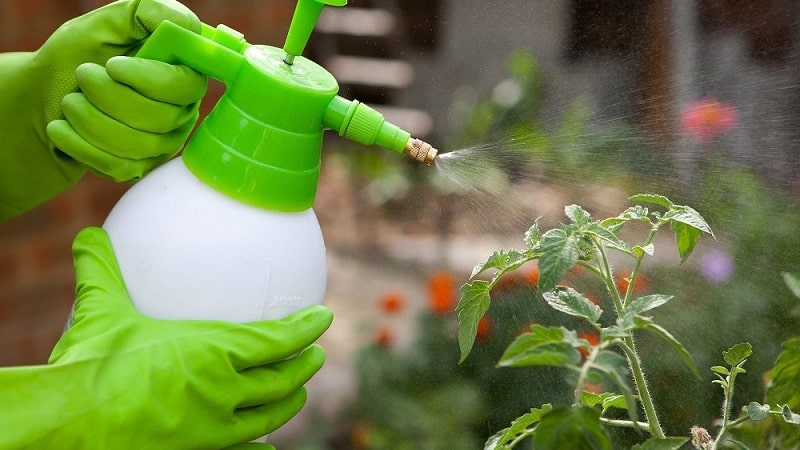
Operating principle
Milk contains fat in its composition, and even whey contains a lot of it. When tomatoes are sprayed with it, a thin film of fat prevents fungal spores from penetrating plants.
Whey has an acidic environment, which does not allow fungal spores to develop. This is the basis for its beneficial effect in the treatment of late blight.
Efficiency
The product is considered effective because fungal spores, not finding food for themselves, dry out and the plant recovers. Since whey is a natural product, it does not have any additional harmful effects on the tomatoes themselves or on the environment.
How to prepare the solution
Making a solution from whey is simple. Take the milk and leave it in a warm place for a day. It will start to sour. After this, the sour milk is heated, and the curd flakes begin to separate from the liquid. The separated liquid is drained - this is the whey.
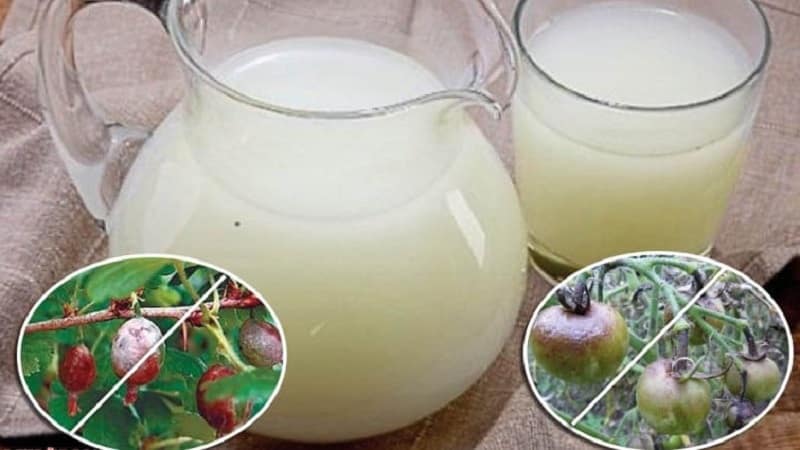
Proportions and cooking instructions
To spray tomato plantings, the whey is filtered through cheesecloth and diluted with water: for 1 liter of serum you will need 9 liters of water. The finished mixture is poured into containers with a sprayer and used immediately. Under no circumstances should the finished serum be boiled - this will significantly reduce its therapeutic effect.
Important! To make 1 liter of whey you will need at least 3 liters of fat milk.
Whey against late blight with various additives
To enhance the effect and quickly defeat late blight, various substances are added to the finished solution. Liquid with copper sulfate or iodine has a particularly good effect on the disease.
With iodine
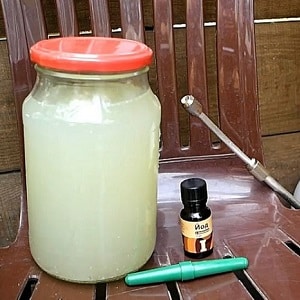 It is believed that one of the reasons for the appearance of late blight is excess nitrogen in the soil. Nitrogen fertilizers are applied to reduce soil oxidation, which is typical for a large part of our country.
It is believed that one of the reasons for the appearance of late blight is excess nitrogen in the soil. Nitrogen fertilizers are applied to reduce soil oxidation, which is typical for a large part of our country.
Iodine improves nitrogen metabolism and reduces the acidity of the earth.In addition, it has an antimicrobial effect and improves the overall immunity of plants. Therefore, twenty drops of iodine tincture are added to the prepared whey solution.
With copper sulfate
Copper sulfate is a salt of copper sulfate. His widely used in the treatment of fungus in plants, dissolving salt crystals in water. It is sold in pharmacies or gardening stores.
When preparing whey with vitriol, it is important to follow the dosage, otherwise the plant will get burns or there will be no effect from the treatment. For 1 liter of whey take 8 g of vitriol solution.
Interesting things on the site:
Why spray tomatoes with iodine serum?
The benefits of whey for obtaining a bountiful tomato harvest
How to properly process
Plants are treated with a whey solution without additives throughout the season. - as a preventive measure. A milk solution with iodine or copper sulfate is used during the formation of ovaries or as needed if late blight has appeared on already grown fruits.
Important! The entire plant is processed. Particular attention is paid to the lower leaves, where a large accumulation of late blight spores is most often observed.
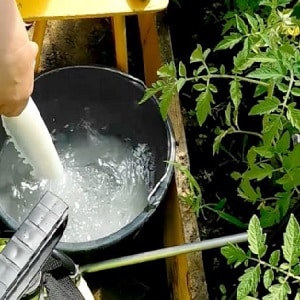 The solution must be filtered; the smallest droplets of liquid should remain on the plant. As for the processing rules, they are the same as for other drugs:
The solution must be filtered; the smallest droplets of liquid should remain on the plant. As for the processing rules, they are the same as for other drugs:
- spray the plants in the morning or evening, when there is no hot sun (a cloudy day is also suitable);
- the mixture should be warm, with a temperature not lower than +20°C;
- if serum with iodine was used, it is not dangerous for the human body - processed tomatoes can be eaten the next day;
- if with vitriol, then eat them no earlier than a week after treatment.
Nuances of processing in greenhouses and open ground
Tomatoes growing in greenhouses usually suffer from late blight less often. Therefore, it is less necessary to process greenhouse vegetables with whey. Keep in mind that the microclimate of the greenhouse changes after spraying, so after treatment the greenhouse is immediately ventilated, and spraying is carried out on damp soil.
Processing on open ground is carried out in warm, windless weather.
Use for prophylactic purposes
Preventive treatment with whey is carried out approximately once a week. or once every 10 days. This treatment is carried out four times during the season, even if no noticeable signs of the disease are visible on the plants. The serum prevents its appearance, so prevention should not be neglected.
Tips and tricks
To prevent late blight from interfering with the harvest, follow the rules of crop rotation: do not plant tomatoes next to potatoes and eggplants, do not use the same place for tomatoes for two seasons in a row, in the period between planting tomatoes, plant these beds with green manure plants.
Besides, the development of late blight is promoted by excessive soil moisture and nutrient imbalances. Therefore, a competent approach to watering and timely application of fertilizers will be an excellent means of preventing this disease.
Read also:
How to prepare a boric acid solution for tomato ovaries
How to feed cucumbers with ash in open ground and greenhouses
Reviews
Let's take a closer look at how experienced summer residents respond to the serum.
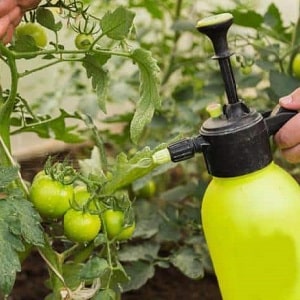 Tatyana, 63 years old: “I’m very afraid of any chemicals in the garden, so whey is the best solution. There is no harm and only benefit from it. I use it for tomatoes, cucumbers, and strawberries.".
Tatyana, 63 years old: “I’m very afraid of any chemicals in the garden, so whey is the best solution. There is no harm and only benefit from it. I use it for tomatoes, cucumbers, and strawberries.".
Nikolay, 47 years old: “I have a big garden and there are beds with vegetables. I adhere to the principles of harmonious housekeeping, try to alternate plantings, and regularly ventilate greenhouses. That’s why my plants rarely get sick. But if late blight suddenly appears, serum is a good remedy. And it also helps as a fertilizer.”.
Masha, 30 years old: “I inherited the garden from my mother, the tomatoes grew quite crowded, late blight was discovered soon after the end of flowering. A neighbor advised spraying with whey. Serum with iodine helped, the spots of the disease disappeared. I’ll remember for the future that you need to clamp the tomatoes at a distance from each other.”.
Conclusion
Late blight is an unpleasant but conquerable disease. One of the main means of treatment is spraying plants with whey, which is made from ordinary milk.
For greater effectiveness, iodine is added to the serum, which creates an acidic and lethal environment for fungal spores, or a solution of copper sulfate.